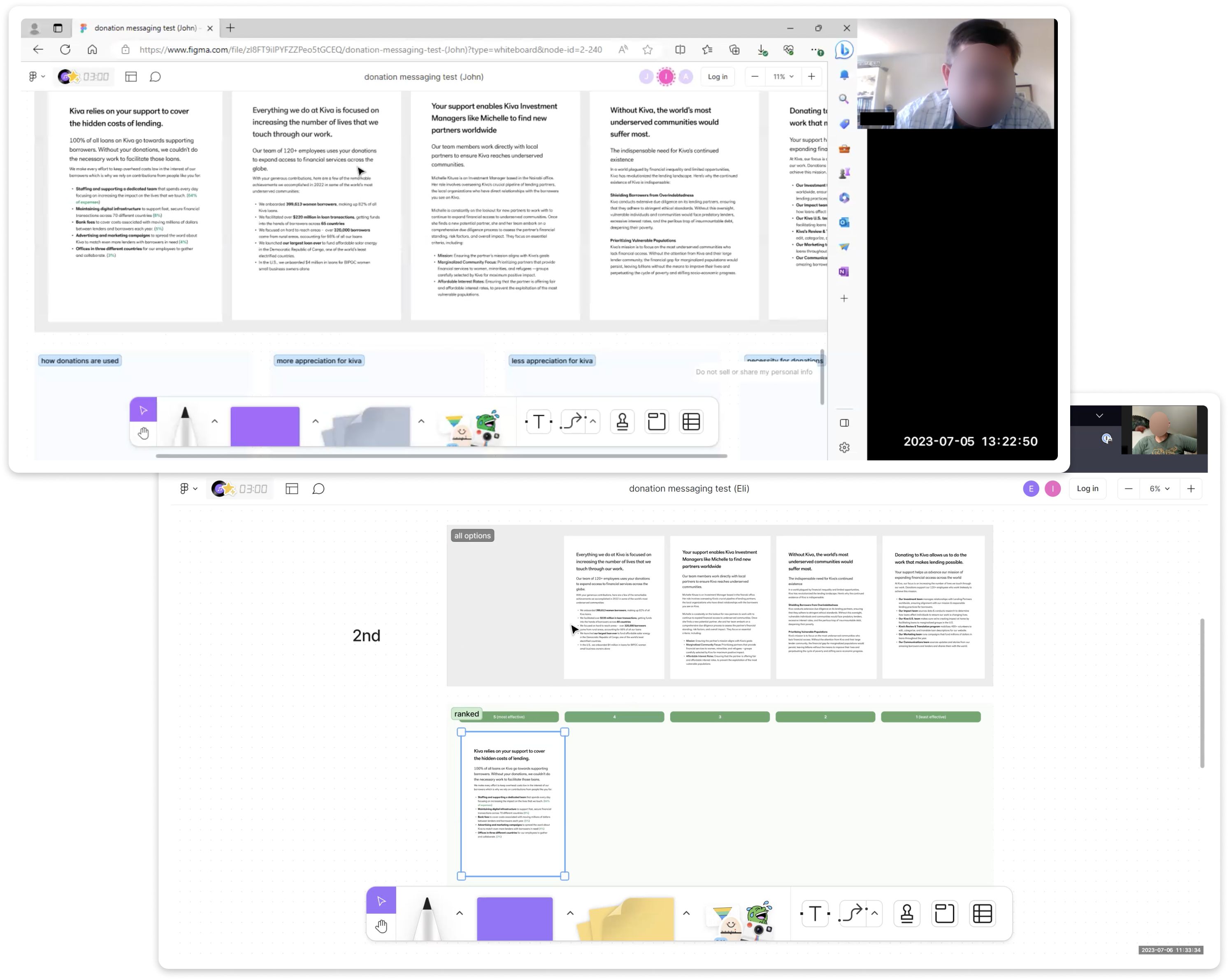overview
CONTEXT
Kiva is a nonprofit organization that provides a platform for crowdfunded microloans. Users can lend as little as $25 to borrowers and when borrowers repay, lenders can reinvest those funds to help other borrowers.
In addition to lending, Kiva users have the option to leave a voluntary donation "tip" during the checkout process to help cover Kiva's operating expenses.

PROBLEM
Currently, 40% of lenders choose not to leave a tip along with their loans. We want to identify what type of content would encourage more donations among these lenders.
ROLE
User Researcher
TEAM
Product Manager, Product Designer
TIMELINE
May 2023 (Phase 1), July 2023 (Phase 2)
METHODS
Survey, Interviews, Usability Testing
TOOLS
HotJar, Zoom, Dovetail, FigJam, Google Sheets
Research Summary
TOP INSIGHTS
1
Infrequent donors view lending and donating on Kiva as competing actions for where to give their money
2
There’s an opportunity to bring the valued qualities of lending over to donating: transparency, multiplied impact, emotional connection, and a sense of urgency and need
3
The donation messages that lenders found most effective in inspiring a donation were:
• A breakdown of Kiva's costs
• Kiva's 2022 impact statistics
• A list of Kiva's teams and descriptions of their roles
IMPACT
Informed checkout experiments
This research helped inform and refine the donation messaging for ongoing checkout experiments. One of the experiments saw an 2.3% increase in donations when including copy that explained the specific costs donations help cover.
Site-wide donation education system
Insights from this research also helped shape a broader strategy around educating users about the work that Kiva does at various touchpoints throughout the lender experience leading up to the donation ask at checkout.
First user research study on donations
This research was the first user study on donation user behaviors and behaviors at Kiva and laid the groundwork for future donation messaging optimizations and continued research on this topic.
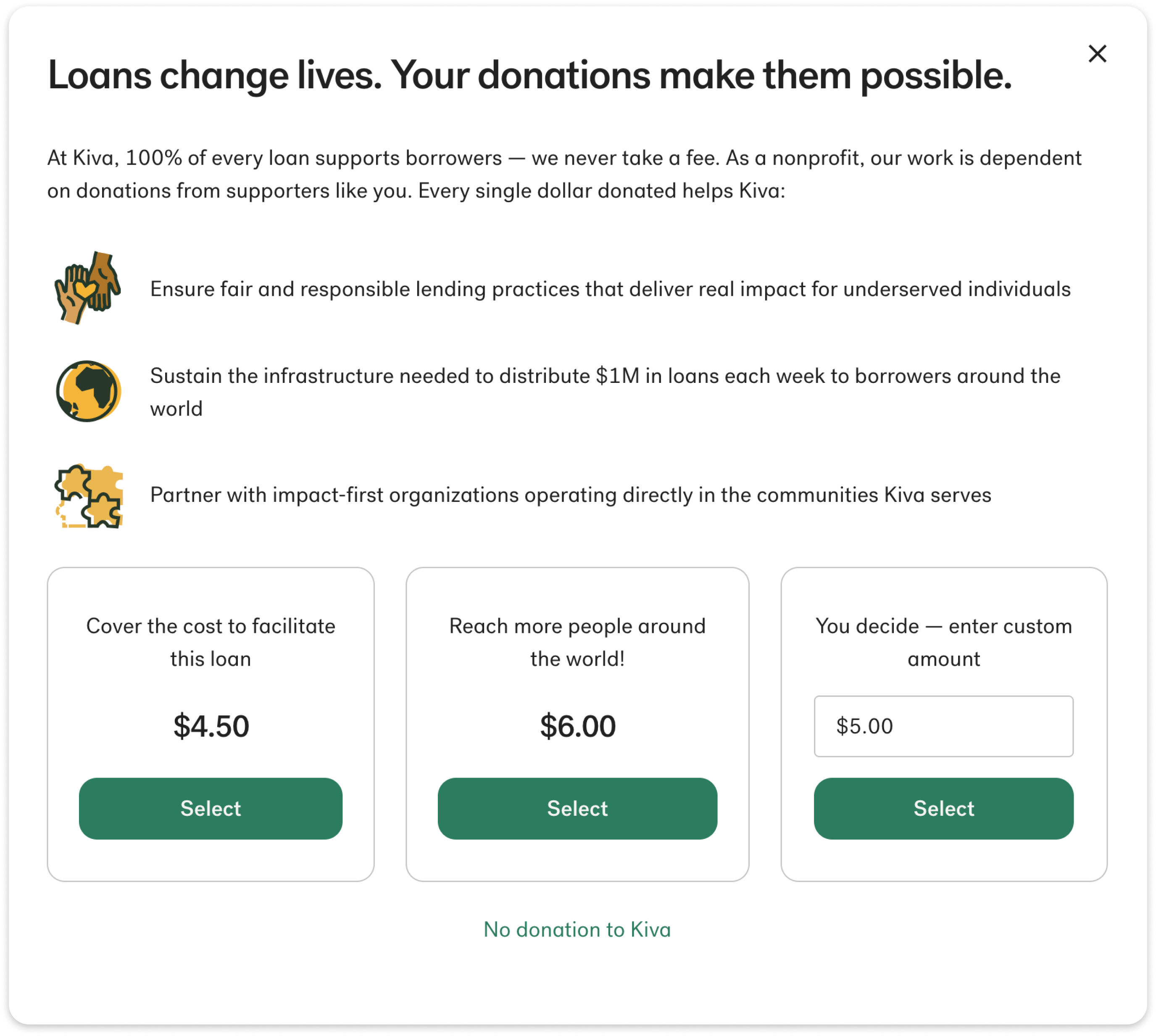
New content and copy for the edit donation modal at checkout saw 2.3% increase in donations
Phase 1:
Understanding USer Behaviors
PROBLEM
Identify reasons why users choose to or not to donate and identify opportunities that could encourage more donations.
GOALS
1
What motivates and discourages users from donating to Kiva?
2
What are the donating behaviors of users outside of Kiva?
3
What motivates and discourages users from donating outside of Kiva?
SURVEYS
Tension between lending and donating
Approach: To capture the rationale behind users' donation/tipping decisions while still top of mind, we launched a brief on-site Hotjar survey on the checkout "thank you" page.
Findings: Only a few non-donating users shared why they chose not to donate and said they preferred lending over donating. We needed interviews to further explore why non-donating users felt this way.
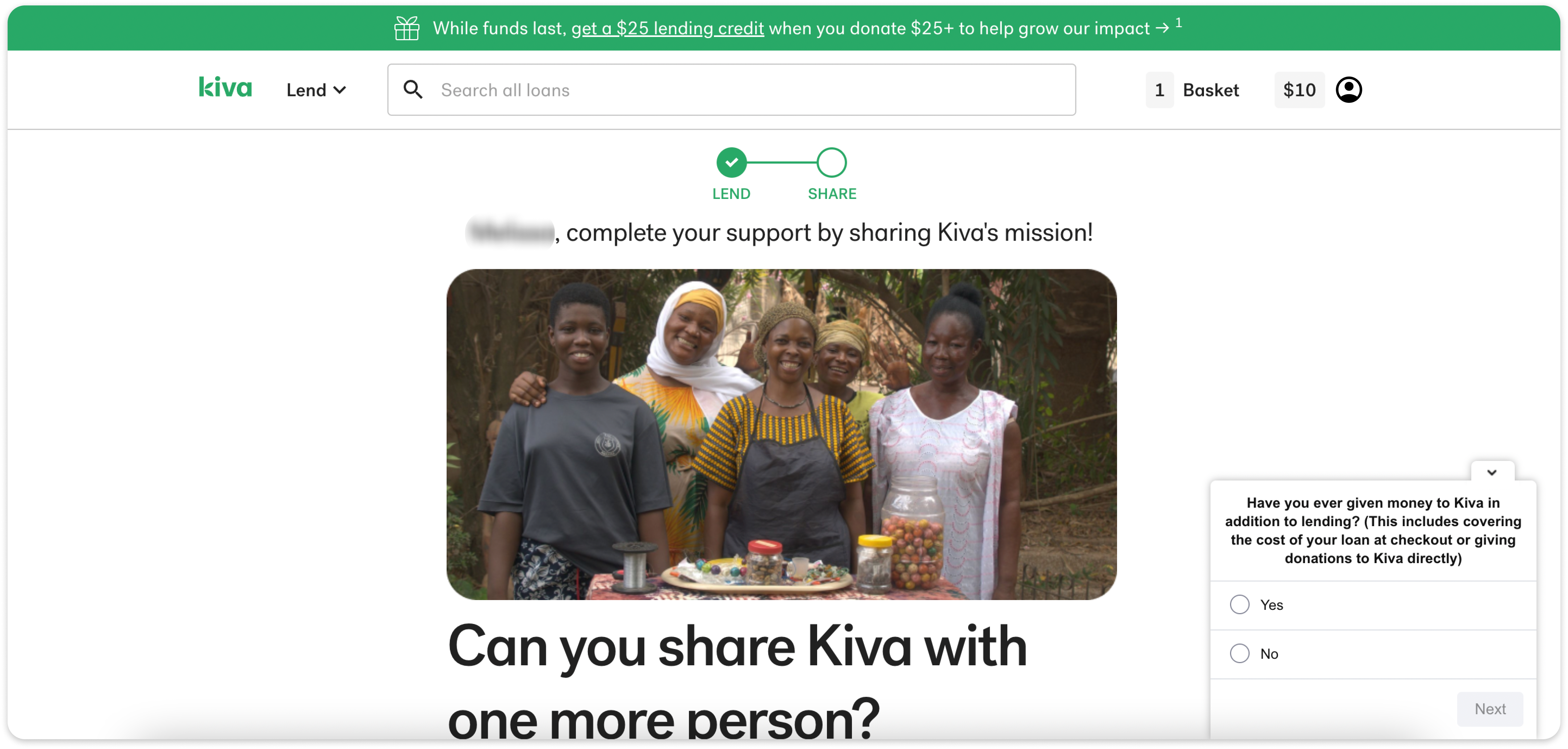
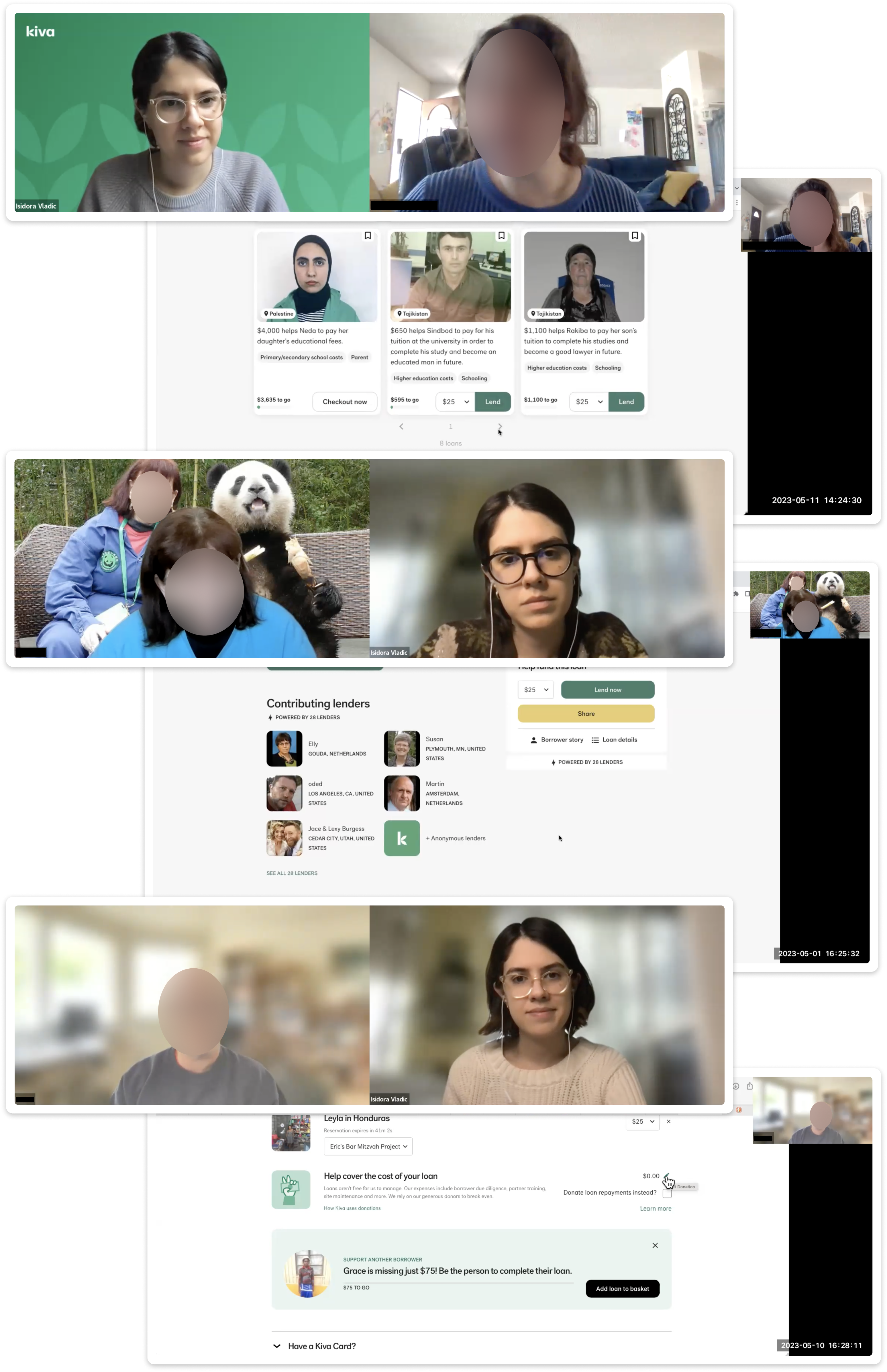
INTERVIEWS
Lending is a more compelling use of users' money
Participants: 9 active U.S. lenders from the past 3 months who rarely or never tipped at checkout in the last 3 years
Approach: In the interviews I had lenders walk me through their loan selection process until checkout to create natural flow that enabled more candid responses than just directly asking them about their donating behavior upfront.
Top insights:
- Users who rarely donate see lending and donating as competing options for their funds
- They don't oppose donating and often support other organizations apart from Kiva
- Lending is preferred due to its perceived higher impact, transparency, and emotional connection to borrowers
Recommendation: To shift perceptions among these users I proposed donation messaging and experiences that align with the qualities lenders value in lending.
APPLYING THE RESEARCH
Cross-functional workshop to ideate new messaging approaches based on research insights
Participants: Members from Kiva's Communications, Marketing, and Impact Investments teams.
Outcome: Identified top five messaging angles for next round of research.
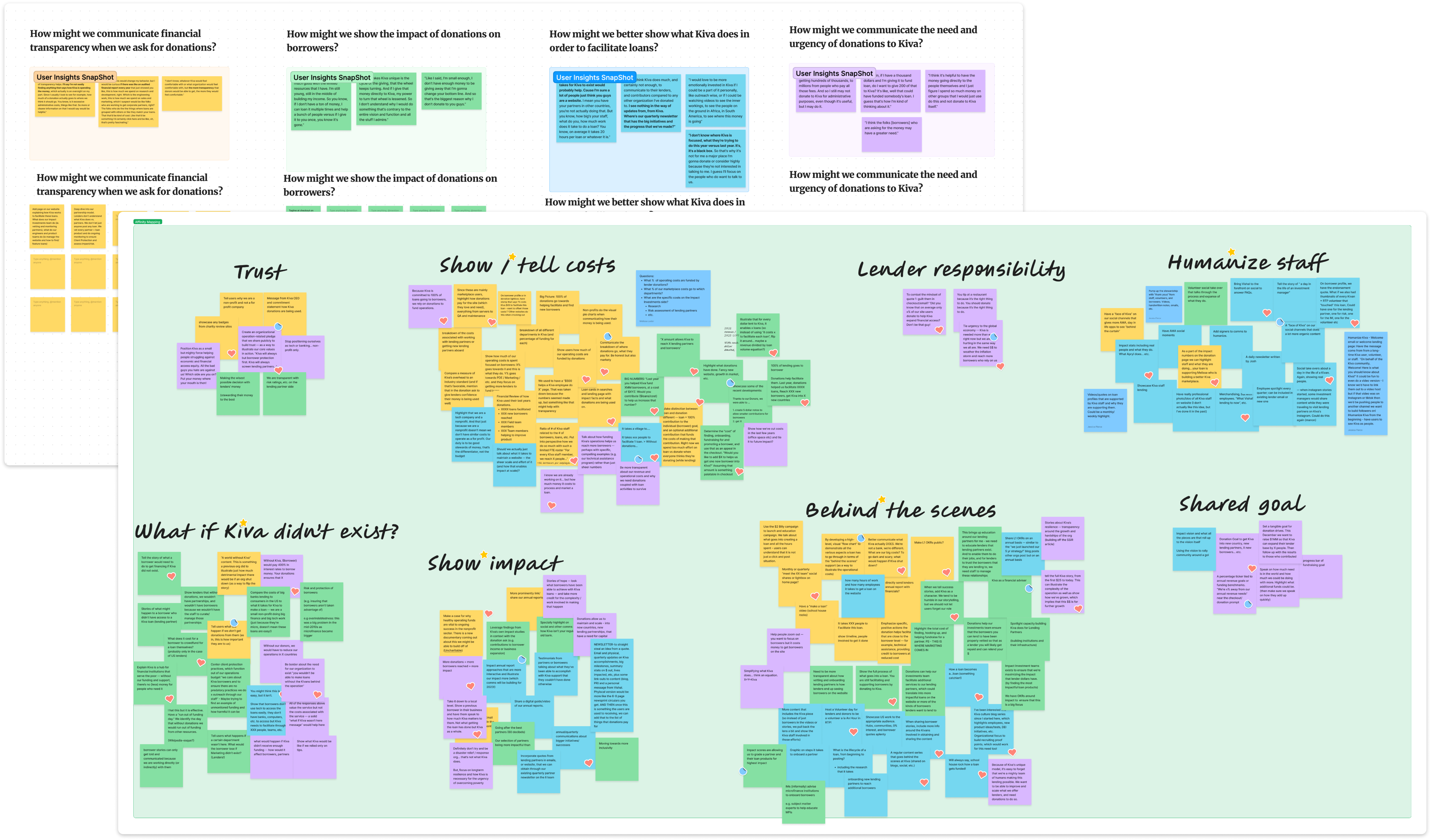
Phase 2:
Donation Messaging
PROBLEM
Identify reasons why users choose to or not to donate and identify opportunities that could encourage more donations.
GOALS
1
Identify top 3 messaging approaches that users find most effective in inspiring a donation
2
Gather user perceptions and interpretations of the different messaging angles
3
Collect actionable feedback to further optimize messaging
USABILITY TESTING
Lenders preferred donation content with more specifics about Kiva's operations and impact
Participants: 9 lenders who never or rarely donate at checkout
Tasks:
- Rate importance and engagement of content
- Rank the messages from most to least effective in inspiring a donation
- Place messages in given categories
Findings: Explanations of Kiva's operational costs, 2022 impact statistics, and descriptions of each of Kiva's teams ranked highest in inspiring donations.
Conclusion
TAKEAWAYS
Surveys are better suited to close-ended questions
Our open-ended HotJar survey asking about motivations for donating did not provide insightful answers. If I were to redo this study this again, I would first conduct interviews to understand users' reasons, then used those findings to create fixed-choice survey answers to determine how big of a theme those answers were among lenders.
Limitations of ranking messaging
When ranking messages in this test, we pinned different content types against each other, missing the opportunity to capture messages that might have been more effective in combination with others or when supplemented with visuals. I included these limitations in the final research report.
Encouraging more candid responses
One approach that worked very well in this research study was walking participants through their lending process. This might have made the interviews longer but it helped get more honest responses by naturally easing them into the interview topic.
